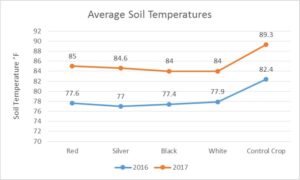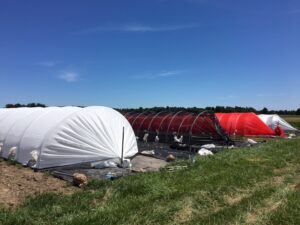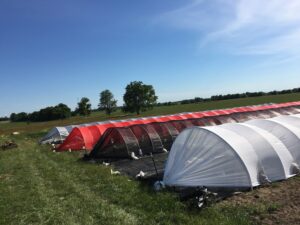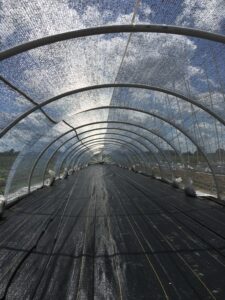Final report for FNC16-1037
Project Information
The purpose of this project is to make use of a structure typically used for late and early season extension, known as caterpillar tunnels, during the hot summer months. Caterpillar tunnels are temporary or semi-permanent hoop structures. The ground support for ours are 1-3/8" galvanized pipe, used as top rail for chain link fence. Each 126" piece of pipe is cut into four sections and driven into the ground on five foot centers in rows 13 feet apart. A 20 foot piece of 1-1/2" pvc pipe is slipped over each galvanized pipe and bent to the corresponding pipe to form a hoop 13 feet wide and approximately seven feet tall. This structure resembles a small high tunnel without any base boards or solid end walls. A post is driven in at the end of each tunnel. For structural rigidity, a ridge rope is tied to one end post, wrapped around the top center of each hoop and tied to the post at the other end. The covering is also terminated at each end by tying to the same posts. Between each hoop, a stake, in our case a piece of rebar, is driven into the ground. These are used as anchors for overhead ropes to keep the cover in place. A sandbag is placed between the rebar and cover to keep the cover on the ground and to protect the cover from the cut end of the rebar. Peaks of the hoops and the valleys of the anchor ropes give the tunnel a segmented caterpillar-like appearance.
Making use of these structures during the summer will make them even more affordable to own by amortizing their use over a longer period. It is hoped that full utilization of these will increase farm profits. We are testing the suitability of shade cloth to cover these structures and comparing the results of the four fabrics. The shade cloths are all 50% shading and are black, white, red, and a reflective aluminized material. Kale and cucumbers were planted in each tunnel and an outdoor control crop through woven black ground cover. The ground cover is used to suppress weeds as cultivation within the confines of a caterpillar tunnel is difficult.
I evaluated each tunnel for its ability to exclude pests, improve working conditions, and increase yields. Random samples of plants were to be selected and monitored for pest pressure. Yields and internal air temperatures were recorded. Soil temperatures were also recorded as they could have an impact on plant performance.
The fabrics were left on the tunnels for the longest period possible in order to evaluate any shortcomings in durability.
Cooperators
- (Educator)
Research
I have been working with caterpillar tunnels for several years. The system is now more mainstream, and kits are commercially available. When I built the first tunnel on my farm, very little information was available about their construction. I started with steel hoops and found them to be less durable than pvc hoops. Over the course of several generations of tunnels, my design evolved to the model used in this project. I was able to reduce the cost of each tunnel while increasing their strength. I have found the bows made from pvc to be much more durable than steel. They are able to bend and flex during high winds where a steel hoop would be destroyed by creasing and folding over.
The choice of rope also evolved. The material used is called pull tape or mule tape. It is designed to pull service lines through conduit. It comes in different strengths but the style I use is rated for 1,800 pounds. It is stronger and less expensive than any other option I’ve found and typically lasts two years under this application.
There are many choices of ground anchors available. I have chosen to use 24” pieces of rebar. When driven into the ground 20”, they make a very solid anchor and are easier to install than a screw style anchor. They are also much less expensive. I like to have only enough rebar above ground to tie the overhead rope to. Extra length creates a point capable of snagging and ripping the cover. Once the rope is tied on, the area between the rope/anchor assembly and the cover is the ideal place to wedge a sandbag. The sandbag holds the cover to the ground. When placed there, it protects the cover from contacting the rebar and ripping. It also prevents the cover from billowing outward and throwing the sandbag off.
2016 Impacts
Within the first 48 hours of planting, 80% of the kale transplants were destroyed by cutworms. The pests must have been present in the soil prior to planting. Organic insecticide, spinosad, was used immediately but with no effect. The rest of the kale was lost over the following week. Cucumbers were unaffected.
The only significant pest pressure on the control crop was from blister beetles on the cucumbers. Pyganic was used to control blister beetles. Two applications were made at a five day interval and were successful. The damage was minimal. The tunnels did seem effective at excluding blister beetles. A large number of moths (primarily imported cabbage moths), however, became trapped in all tunnels. If it had been a species which feeds on cucumbers, or the tunnel contained a crop which they fed on, it would have been devastating. In addition, after the harvest period ended, squash bugs took up residence within the tunnels.
Cabbage loopers did breed in the black tunnel, and their caterpillars fed on cucumber fruits and leaves. I have never observed that in field production and believe the situation was created by the entrapment of the moths and the absence of their typical feeds. Caterpillars were controlled with an application of BT. Yields were affected because of this.
As for worker comfort, we found a wide variance in each tunnel. With the exception of the red cover, all the shade cloths were manufactured by Dewitt but each have a different weave. The red and white were identical in structure and had thicker threads and a tight weave. The black cover had much finer threads, looked more like window screen, and was the only structure you could see through. The reflective cover had a thread thicker than the black, finer than the red and white, and a more open weave. The material construction was really the largest factor in worker comfort. While the air temperatures in each tunnel were the same as the outdoor temperatures, air circulation in the red and white tunnels was severely limited. This made working in them unbearable. It was generally more comfortable in the black or silver tunnels than working outside.
Due to the massive loss of kale seedlings within days of transplant, only cucumber yields were recorded. Two tunnels yielded less than the control crop. The black tunnel yielded 18% less pounds of cucumbers and the silver tunnel yielded 6% less than the control crop. The white tunnel yielded 16% more pounds of cucumbers and the red tunnel yielded 18% more. Yields in the black tunnel were affected by significant pest pressure. More testing will need to be done to determine if the type of color has a direct relation to yields. The project will be repeated in 2017 on a different field.
Soil temperature variances were negligible with the average soil temperature being: reflective silver, 77 degrees Fahrenheit; black, 77.4 degrees; red, 77.6 degrees; white, 77.9 degrees; outdoor control crop, 82.4 degrees. The control crop was found to be 5.4 degrees warmer than the coolest tunnel (reflective silver).
2017 Impacts
The project was repeated in 2017. There were multiple issues that prevented the collection of any substantial yield data; namely, insects and other varmints:
Before harvest began, squash bugs decimated the cucumber plantings. I believe they entered the tunnels by crawling under the landscape fabric used for weed suppression at the outer edges. Squash bugs took refuge under the fabric, making them difficult to scout for and impossible to manage. Prior to planting the experiment crops, a field crop of zucchini was established near the experiment plot. The squash bugs moved from the zucchini to the nearest tunnel (silver) and then onto each other plot in succession. Due to this damage, each cucumber planting was destroyed.
Just before the kale was to be harvested, ground hogs entered the tunnels by chewing through the sides. Within 72 hours, all of the kale inside the black tunnel and white tunnel had been destroyed.
Cucumber beetles also infiltrated each tunnel at a population less than one per plant with the exception of the silver tunnel which had populations of two or more per plant. They were much more severe on the control crop with populations of greater than five per plant. Cucumber beetles were controlled with Pyganic. This was found to be effective inside the tunnels but ineffective on the control plot.
Cabbage loopers and imported cabbage moth larva were also found in each tunnel with a population of about one per plant. Populations in the control plot were on average three caterpillars per plant. Dipel was used for control. It was highly effective to knock down populations; however, pest damage continued and was severe on the outdoor crop.
Each shade cloth was somewhat effective at excluding flying insects, with the silver cover being the least effective. The Aluminet shade cloth was found to be significantly less durable than the other three varieties of shade cloth. It tore easily and had multiple holes from the initial installation. The weave is also less dense than the others. Either of these issues could have resulted in it being less effective at excluding pests.
Using shade cloth for insect exclusion is possible, however, not without a watchful eye and quick implementation of counter measures. Overall pest pressure is lower and organic chemical controls are more effective. Rigorous scouting is still necessary, and any pests that are found need to be dealt with immediately as I have found the tunnels to create great refuge for pests. The only insect predators I have found inside the tunnels were spiders. I found scouting for pests to be more difficult inside multiple tunnels than it would be in the open field. Chemical controls are also more difficult to apply. Entering a tunnel requires one to lift the cover and bend or stoop to enter. Doing so with a backpack sprayer may be physically difficult for many farmers.
The temperature records the second year were mostly identical to the first. In both years, the temperature of each tunnel varied slightly but less than one degree from one another. In 2017, temperature averages were as follows; Red 85 degrees, silver 84.6 degrees, black 84 degrees and white 84 degrees. In 2016 and 2017, the control plot was 4.9 and 4.8 degrees warmer than the average temperature of all four tunnels. Differences in soil temperatures varied with the weather. On rainy days, temperatures inside the tunnels and the control were nearly identical. On sunny days, the control plot was typically seven or eight degrees warmer than inside the tunnels. Only about two weeks’ worth of data was collected in 2017 due to the massive destruction of crops by pests (priorities were shifted elsewhere on the farm).
I believe the best attribute of these tunnels was the appearance of the fruits. While sunscald was rare in the outdoor crop, it was completely absent from the tunnels. Wind damage was also absent from the covered plots. Wind damage will vary by location and season but is of concern in our area, and this method of production eliminated it. Because of the lack of pollinators, parthnocarpic greenhouse varieties were chosen. These varieties were Socrates, Picolino, and Tyria, all of which are thin skinned varieties suited to protected culture as their skins are easily blemished in the field. While many factors affect the quality of field grown cucumbers, the quality of the cucumbers grown within the tunnels was consistently very high. The protection offered by these structures shows promising results for high value crops, such as cucumbers. In addition, while soil temperatures did not appear to show a correlation in yield of our cucumbers, a nearly 5 degree temperature difference over an unshaded plot could be significant for other crops.
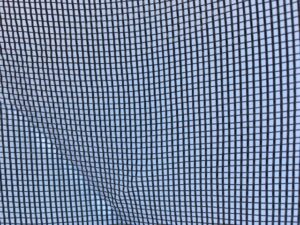



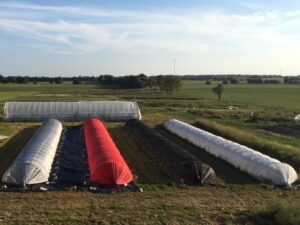
Accomplishments
All of the ground supports were driven in on May 1, 2016
Construction of the tunnels was completed on June 7, 2016
All plants were transplanted on June 9 and 10, 2016.
The first cucumbers were harvested on July 1, 2016. The control crop yielded more in the first week but the others then caught up.
Harvesting concluded on August 28, 2016.
University of Missouri and Lincoln University staff and students toured the farm and learned about the project.
On October 6, 2016, I spoke at a SARE grant writing workshop. It was hosted by Lincoln University and was held at MU Southwest Extension Center in Mt. Vernon. I spoke about my experience writing my grant and performing the experiment.
On January 12, 2017, I removed the covers from the structures.
Tunnels were completed for follow up research on June 5, 2017
Transplants were planted to experiment plots on July 1st, 2017
A tour of local farmers and university staff took place on September 12, 2017
Educational & Outreach Activities
Participation Summary:
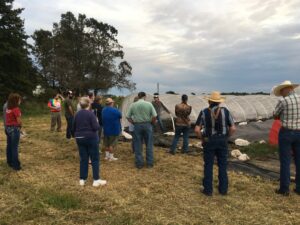
On September 27, 2016, University of Missouri staff along with several students and NRCS staff toured the farm and learned about the project. There were approximately 20 in attendance.
On September 12, 2017, we hosted a field day with the University of Missouri Extension as part of their Lawrence County Twilight Tour series. There were about 30 attendees. Our findings were shared with attendees as part of the tour. Information about the tour was advertised through flyers and via social media with the help of MU Extension.
Learning Outcomes
I learned that shade cloth is a useful summer cover for caterpillar tunnels. It does offer some benefits of insect exclusion and protected culture while lowering soil temperatures. Higher quality crops can be produced at higher yield using this method. Growers need to realize that it does add another layer of management to their operation. Pests left unchecked can proliferate within the refuge of the structure. But, with proper management, pest pressure can be reduced.
The very high value European cucumbers, which typically can only be grown in a high tunnel or greenhouse, can be produced within a caterpillar tunnel. However, the height of my caterpillar tunnels made trellising troublesome. The thirteen foot width only creates a 7 foot tall hoop. For trellising cucumbers, they really need to be a narrower width to create a nine foot high peak. Otherwise, plants need to be lowered so early that the fruits often end up on the ground.
I was impressed with the reduction of soil temperatures. Next, I plan to grow summer lettuce with this method as well as cucumbers.
I will continue to use structure like this in my operation. I do want to make some changes though. The experiment started with the plastic covered caterpillar tunnel model and sought to experiment with the shade cloth to find a use for them in the summer. I feel that for my farm, which is exceptionally exposed and windy, that the management of the typical plastic covered caterpillar tunnels is burdensome. Venting these tunnels on very windy days can damage the plastic. I have made similar structures using baseboards and conventional wire lock fastening systems for the plastic and they are much easier to manage. I think that a baseboard resting on the ground would reduce the pressure of crawling insects when shade cloth is applied. I feel like this is the logical path forward for these low cost structures.
Project Outcomes
Yields varied from tunnel to tunnel with yields being lowest under black shade cloth. More research needs to be done to determine if the color of shade cloth has any impact on overall yields of cucumbers or kale.
